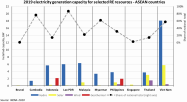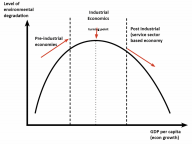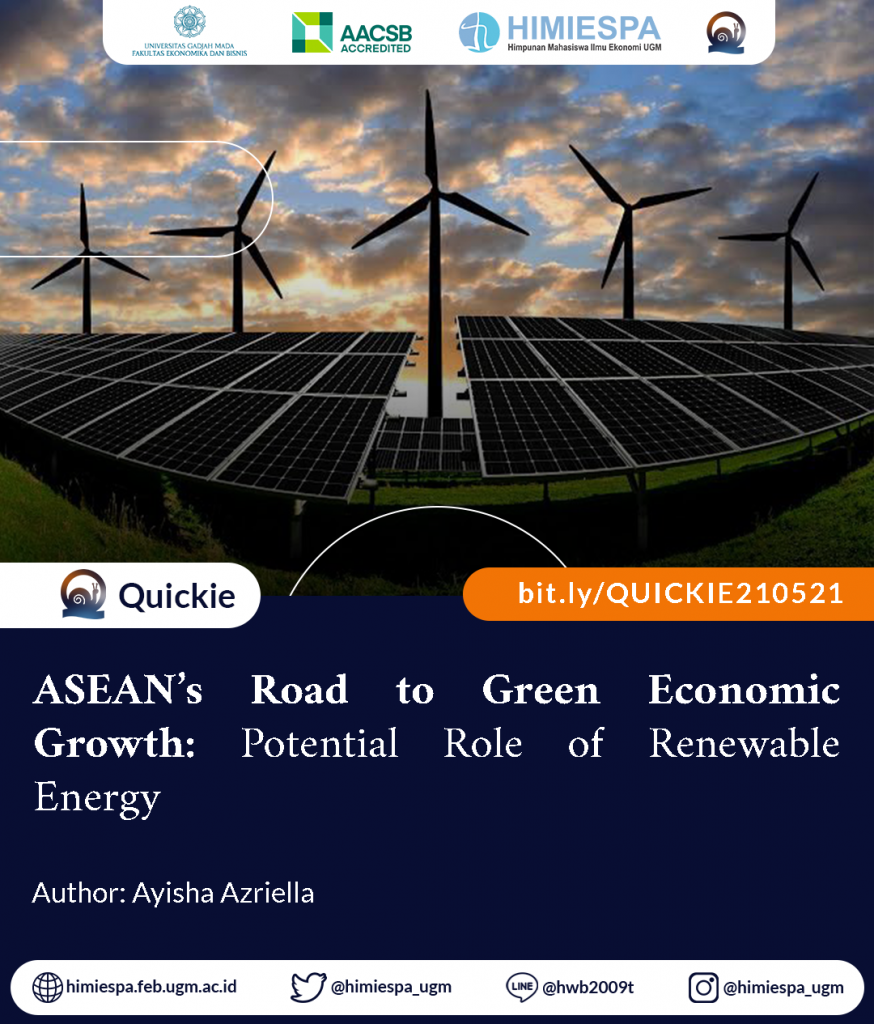“ASEAN’s Road to Green Economic Growth: Potential Role of Renewable Energy”
Climate change is no longer an issue that can be ignored and it must be dealt with sooner than later. Since the industrialization era, levels of the atmospheric greenhouse gases (GHG) have been increasing exponentially. According to the Intergovernmental Panel on Climate Change (2014), both economic and population growth plays a major role in the release of CO2, NO2, methane, and other hazardous GHG, causing global temperatures to rise. Thus, in order to suppress emissions that are detrimental to ecological and physical sustainability, sectors performing activities that contribute vastly to pollution, such as the energy sector, must make large-scale accelerations towards a green culture (Ritchie and Roser, 2020).
Data from the World Resource Institute (2020) show that 73.2% of global GHG emissions is generated from the energy sector. Moreover, the 2019 Southeast Asia Outlook states that overall electricity demand of ASEAN countries increases at a 6% rate every year, which is considered to be one of the fastest growth in the world. As economic growth is based on the rise of production, energy consumption would rise inevitably in emerging economies (Anwar, et al., 2020).
Members of ASEAN have now set regional targets for renewable energy (RE) consumption that must be reached within a certain time frame to eliminate fossil fuels and decarbonise the energy system in the near future (ASEAN Centre for Energy, 2021). Derived from the name itself, RE is energy that is collected from natural sources that constantly replenishes and is inexhaustible in duration (NRDC, 2018). This writing will discuss the current condition of ASEAN’s energy sector, MRE adoption potential, trade-off, and policy recommendations to increase RE capacity.
ASEAN’s Energy Sector
There is an imminent need for member states to not only reduce carbon emission but increase RE share of total primary energy supply (TPES); seeking for investors to bring low emission technologies is needed for long-run sustainability. The abundance of natural resources accessible in the 10 countries makes ASEAN standout as an investment opportunity, thus member states require a large source of energy to process the natural capital (Anwar, et al., 2020). With energy being the foremost device for economic growth as it is the main input of production, it plays a major role in generating jobs, commerce, agricultural produces, and other outputs, thus increasing the Gross Domestic Product (GDP) of the country, along with the living standards of the people (Anwar, et al., 2020). Therefore, renewable energy would be the best viable method to reduce emissions while still ensuring a secure electricity supply needed for development (Erdiwansyah, et al., 2019).
Although Southeast Asian countries have been increasing their renewable energy capacity, it is still highly dominated by traditional or first-generation biofuels. The traditional method of processing biofuels normally uses food crops as feedstock such as sugarcane, palm, and cassava,
that will eventually be converted into bioethanol through biochemical processes that involve a lot of heat (Subramaniam, et al., 2021). Thus, this renewable energy source is often criticized as they have yet to result in environmental sustainability due to the harvesting method of the raw materials that may affect food supply and biodiversity loss, along with the hazardous chemical output.
While the production of advanced biofuels in more developed countries convert waste to energy, required equipment to do so is still costly and should not be an investment priority to increase modern renewable energy (MRE) consumption (Vidinopoulus, et al., 2020). ASEAN countries must now focus on MRE sources that are available in the region due to geographic factors such as wind, hydro, solar, and geothermal, instead of allocating all sustainable energy budgets on developing biomass or biofuel.
MRE potential for ASEAN countries
Before focusing on investments, Southeast Asian countries have been focusing on increasing MRE supply shares. As of 2017, Indonesia, Thailand, Malaysia, and Vietnam account for 36%, 20%, 13%, 12% of ASEAN’s TPES, respectively. From the total TPES of ASEAN, only 7% of it is sourced from modern renewable energy, while 18% of it is composed of biomass and 75% of fossil fuels as shown in figure 1. The difference between MRE and biomass value show that the current uptake of infrastructure for MRE is still low across Southeast Asia (Vidinopoulos, et al., 2020).

Figure 1: 2017 Total Primary Energy Supply (TPES) of ASEAN Countries
Source: IEA Data and Statistics 2020
Considering that the target set by ASEAN to ASEAN Energy Outlook (AEO) is to reach a 23% RE share of TPES (excluding biomass) by 2025, reduction of nonrenewable energy plans involving biomass must be reevaluated as it is said to be more dangerous than fossil fuels. Indonesia’s program to increase palm biodiesel production to boost RE supply has been criticized by many international bodies, but as seen from figure 1, they are reliant on biomass production. Due to the geographic structure of Southeast Asian nations that houses an abundance of natural resources, there is a high RE capacity that can be explored and utilized by members to increase RE share without biomass.

Figure 2: 2019 RE Resources Electricity Generation Capacity of ASEAN countries
Source: IRENA 2020
According to 2019 data presented in figure 2, hydro energy has a significant potential in ASEAN countries; Vietnam’s hydro capacity share constitutes for 60% of the total national MRE sources share or 18 gigawatt (GW) and Laos is the first country to export hydroelectricity to Thailand and has set a target to produce 24 GW to use as primary energy source. Resources from the Mekong region will highly contribute to meeting the demand of hydroelectric energy that can also be exported. On the other hand, although becoming more apparent in the Philippines, Vietnam, and Thailand, wind has the smallest potential in Asia due to the sizable amount of ground needed. However, the latest policy scenario for 2016 estimates that wind power will be the fastest-growing electricity technology as countries implementing it have been intensely finding investors to fund and develop needed infrastructure (Erdiwansyah, et al., 2019).
Moreover, geothermal generated energy has been produced by the Philippines and Indonesia; power plants are very significant in increasing MRE capacity in both countries. Indonesia has passed aggressive policies to attract investors and encourage them to explore areas that have previously been restricted but are now opened in order to reach the 29 GW target. The Philippines has also created a new policy scenario to increase capacity. However, the rise in geothermal energy is minimal due to the high cost needed for exploration purposes and difficulty competing for land demanded for coal and solar energy power plants (Erdiwansyah, et al., 2019).
ASEAN solar power plant capacity has been increasing rapidly since investment incentives and trade agreements have been imposed. Thailand and Malaysia have joint ventures with Chinese producers of solar panels in the form of FDI and free trade agreements respectively, thus easing the infrastructure development process.
By increasing awareness on the dangers of traditional or first generation biofuel, governments can act to increase land-use efficiency by repurposing land normally used for unsustainable agriculture activities (mostly palm plantations in Indonesia and Malaysia) for other MRE infrastructure. These land spaces can then be progressively repurposed for solar PV as global palm oil statistics state that production is equivalent to 46 MWh/Ha/yr, while large solar projects in Australia have produced 950 Mwh/Ha/Yr.
The problem would lie in countries that do not have as much unallocated land or reusable land as Indonesia and Malaysia. Singapore, Brunei, along with the Philippines and Vietnam, does not have much space for area-incentive MRE infrastructures due to land mass, population, and industrialization era. This shows that there is a possibility that although MRE consumption and capacity would rise, investment opportunities and trade must be looked into for long-term sustainable growth potential.
Environmental Kuznet Curve
In understanding the difference in fostering sustainable growth in developed and developing countries, the Environmental Kuznets Curve (EKC) hypothesis will be used. This hypothesis states that there is an increase in carbon emission along with exploitation of natural resources due to increased income at the early stages of economic growth; following that would be a gradual decline in environmental degradation as it moves toward improving technology and expanding the tertiary sector that helps contain carbon emissions. Figure 3 shows the inverted u-curve that illustrates the EKC hypothesis.

Figure 3: Economical Kuznet Curve
Source: EconomicsHelp 2019
Although results of research done regarding the viability of the EKC hypothesis vary vastly, Grimes and Roberts (1997) said that it is much more likely to occur in developed countries with inferior political and trade power. When tested on more mature economies such as the EU and OECD, the exact maximum point can be clearly identified (Maneejuk, et al., 2020). For ASEAN member states, although calculations have shown that the hypothesis is valid in a sense that during later periods the magnitude of negative impact of GDP on pollution increases (Anwar, et al., 2020). Furthermore, the turning points still change, unlike the one in developed countries with one tipping point.
A common assumption is that the EKC hypothesis is more clearly seen in developed countries as developing countries lack environmental awareness, thus normally prioritizing economic development through urbanization (Maneejuk, et al., 2020). This shows that increasing MRE
capacity and consumption would not have a substantial impact on global GHG emission in the long run; technological advances gained through investments and trade agreements would be the key to decrease the pollution concentration or requirement during production. Although RE may not have an adverse effect on the economy of most developed countries, ASEAN could be different due to its reliance on the energy sector for national income.
Trade-off between economic growth and environmental quality
Many researches have put emphasis on the idea that income has a positive relationship with environmental degradation. Therefore, oftentimes, there is a conflict of which one to prioritize, economic growth or sustainability. For ASEAN member states, conflicting policies may also result in the difference of methods to reach stated RE consumption targets.
One of the cases would be that only the ASEAN RE consumption goal states that the targeted renewable energy share excludes traditional biomass. The acceptance of this goal is still questioned as Indonesia’s and Malaysia’s economy relies heavily on the income of the palm oil sector. In Indonesia, the palm oil sector alone employs an estimate of 16 million people and the commodity itself constitutes 3.5% of economic growth, thus playing a role in alleviating poverty.
According to the Coordinating Minister for the Economy of Indonesia, the government believes that the WTO should not create policies regarding national palm oil areas as there are positives to this sector, such as increased welfare. As of now, Indonesia has no plan to reduce its land use on palm plantations as they highly advocate for further exploitation of the sector; some statistical data show the reduction of CO2 emission from palm biodiesel, however the land use efficiency and future demand is what should be considered.
What this means is that although some ASEAN countries such as Singapore and the Philippines are more proactive in implementing green economy by acquiring clean technologies and infrastructure, countries such as Indonesia, Malaysia, and Vietnam are dominated by trade of agricultural and manufactured goods that uses extensive heat and electricity, thus currently still relying on fossil fuels or biomass supplied (Nathaniel, et al., 2019). Therefore, the inflow of green FDI will be highly beneficial as it may improve the biofuel production process and help developing countries experience modernization of sustainable technology that gives opportunities for more cross border trade (Subramaniam, et al., 2021).
With that, the aforementioned long-term sustainable growth requires a high volume of green investments and policy evaluation to be achieved. To entice investors, ASEAN countries are recommended to review its policies. Policy makers may not be familiar with the condition since the environmental revolution, though to realise the total RE technical potential, regional electricity grid integration would be beneficial (Vidinopoulos, et al., 2020). With some areas having less available land and also countries having more access to certain MRE technologies,
people of authority should revise policies on grid access and land property rights to see the positive environmental impacts.
Other regulatory actions that can be taken would be: (1) the introduction of environmental taxes, (2) increasing the awareness of the people through educational programs, and (3) defining public property rights (Nathaniel, et al., 2020). All of this would mean that sectoral economic growth opportunities may have to be disregarded to increase sustainability. Furthermore, without the investments for more efficient MRE production, economic growth would be difficult to reach. With that, the mentioned policies are meant to help ASEAN member states achieve sustainable economic growth without having a trade-off between it and the environment.
Conclusion
ASEAN countries must now focus on modern renewable energy (MRE) sources that are available such as wind, hydro, solar, and geothermal. To reach the estimated capacity, they must attract more private investors to fund the needed large up-front capital to set up infrastructure used to increase the country’s MRE capacity. The public sector also needs to contribute by improving policies and frameworks to incentivize MRE production. In addition to that, the nations should also evaluate integrated approaches that involve multilateral power trade to reduce costs as it considers the demand aspect of RE (IEA, 2019). This shows that despite the urgent need of Southeast Asian countries to alter its energy supply plan, it’s capacity and capability is very much affected by economic and political factors.
References
Anwar, Ahsan, Muhammad Siddique, Eyup Dogan, and Arshian Sharif. 2021. “The moderating role of renewable and non-renewable energy in environment-income nexus for ASEAN countries: Evidence from Method of Moments Quantile Regression.” Renewable Energy 164 (February): 956-967. Accessed 19 April 2021. https://doi.org/10.1016/j.renene.2020.09.128
Erdiwansyah, Mahidin, R. Mamat, M.S.M. Sani, Fitri Khoerunnisa, and Asep Kadarohman. 2019. “Target and demand for renewable energy across 10 ASEAN countries by 2040.” The Electricity Journal 32, Issue 10 (December): 106670. Accessed 19 April 2021. https://doi.org/10.1016/j.tej.2019.106670
International Energy Agency. 2019. Southeast Asia Energy Outlook 2019.
Maneejuk, Nutnaree, Sutthipat Ratchakom, Paravee Maneejuk, and Woraphon Yamaka. 2020. “Does the Environmental Kuznets Curve Exist? An International Study.” Sustainability 12 (November): 9117. Accessed 8 May 2021. doi:10.3390/su12219117
Nathaniel, Solomon, dan Syed Abdul Rehman Khan. 2020. “The nexus between urbanization, renewable energy, trade, and ecological footprint in ASEAN countries.” Journal of Cleaner Production 272 (November): 122709. Accessed 19 April 2021. https://doi.org/10.1016/j.jclepro.2020.122709
Pettinger, Tejvan. 2019. “Environmental Kuznets curve.” Economics Help, September 11. Accessed 7 May 2021. https://www.economicshelp.org/blog/14337/environment/environmental-kuznets-curve/
Ritchie, Hannah and Max Roser. 2020. “C02 and Greenhouse Gas Emission.” Our World in Data, August. Accessed 29 April 2021. https://ourworldindata.org/co2-and-other-greenhouse-gas-emissions
Ritchie, Hannah. 2020. “C02 and Greenhouse Gas Emission.” Our World in Data, September 18. Accessed 29 April 2021. https://ourworldindata.org/co2-and-other-greenhouse-gas-emissions
Shinn, Lora. 2018. “Renewable Energy: The Clean Facts.” Natural Resources Defense Council, 15 June. Accessed 13 May 2021. https://www.nrdc.org/stories/renewable-energy-clean-facts
Subramaniam, Yogeeswari, dan Tajul Ariffin Masron. 2021. “The impact of economic globalization on biofuel in developing countries.” Energy Conversion and Management: X 10 (June): 100064. Accessed 4 May 2021. https://doi.org/10.1016/j.ecmx.2020.100064
Vidinopoulos, Ashley, Jonathan Whale, dan Ursula Fuentes Hufilter. 2020. “Assessing the technical potential of ASEAN countries to achieve 100% renewable energy supply.” Suitable Energy Technologies and Assessments 42 (December): 100878. Accessed 19 April 2021. https://doi.org/10.1016/j.seta.2020.100878
- “Industri Kelapa Sawit Mampu Bangkitkan Ekonomi Nasional dan Media.” Badan Pengelola Dana Perkebunan Sawit, February 8. Accessed 5 May 2021. http://www.bpdp.or.id/industri-kelapa-sawit-mampu-bangkitkan-ekonomi-nasional-dan media
- “Energy Outlook and Cooperation in the ASEAN Region.” ASEAN Centre for Energy, March 16. Accessed 5 May 2021. https://aseanenergy.org/energy-outlook-and-cooperation-in-the-asean-region/

